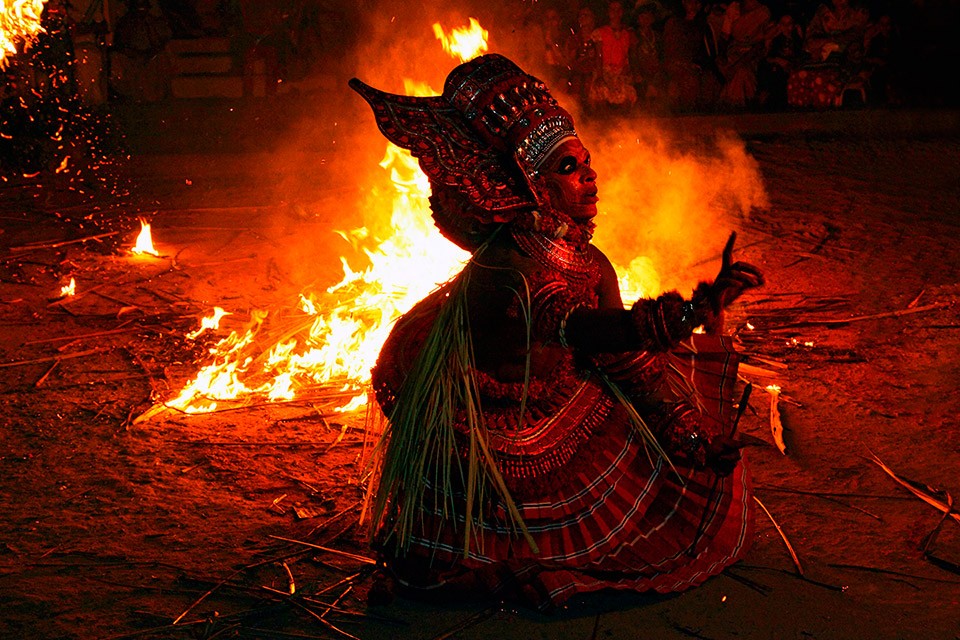
The Indian Ritual of Theyyam through Shyjith Kannur’s Lens

Theyyam is a ritualistic performance which can be described as the most visible, spectacular art form in Malabar (the northern part of Kerala, southern India), associated with myths and legends. Theyyam is a form of worshipping gods, goddesses and legendary heroes that is based on a rather simple concept: after suitable preparatory rituals, the god or goddess belonging to a temple temporarily manifests itself in the body of an empowered man (the performer), thereby elevating him to divine status.
It is one of the oldest indigenous and mystic ritual art forms of North Kerala. As a living cult with century old traditions, rituals and customs, it embraces almost all castes and classes of Hinduism. Its roots can be traced back to 1500 years ago, and it still preserves its tribal and Dravidian features. Theyyam ceremonies usually take place either within the precincts of a small shrine usually called Kavu, Kazhakam, Muchilottu, Mundiya, or Sthanam, in the yard of an ancestral house, or in an open space with a temporary shrine called a “pathi.”
The costume as well as the facial makeup of each Theyyam varies according to the role and myth of the form, which speaks volumes about the nature of the particular theyyam. The artists prepare most of the costumes themselves using indigenous pigments and other materials.
The costumes of a Theyyam are made out of cutting and painting coconut sheaths in black, white and red patterns, fresh coconut fronds form skirts, fashioning breasts out of dry coconut shells and tying a red cloth around the waist.
A Theyyam’s makeup is done by specialists. There are different types of face painting for which primary and secondary colours are used. Therefore, it is essential that the makeup artist have perfect knowledge of primary and secondary colour combinations. Sometimes, it takes hours to paint the faces due to the strict rules of tradition.
Each individual caste has the right to perform certain deities and all performers must pose a wide range of extraordinary skills. They must know the ritual and the character of every deity. They have the inherited right to perform, know how and which songs to sing, how to dance with the drum, and how to do the complicated make-up and dress for their costumes.
Theyyam is not a profession or calling that can be adopted. The artist’s shrine rights are always inherited from the mother’s family and when he marries, he also acquires the shrine rights of his wife’s family. The artists share a common training and tradition in which the process of becoming the deity is achieved after intense mental, physical and spiritual preparation. All Theyyam artists must be able to do much more than just perform. Every deity’s physical appearance conforms to an image envisaged centuries ago in the dream or vision of a respected guru.
Theyyam reveals the human capabilities of abstraction, synthesis, and idealization; it describes social and economic activities and reveals practices, beliefs and ideas. It provides a unique insight into spirituality, intellectual life and cultural adventures. Since the Theyyam performer transforms to the status of a particular deity, Theyyam is very much a divine dance. Invoking a god or goddess in his body, he dances through the compound of the sacred space where deities are worshipped. The dance is considered not for mocking or impersonating gods or goddesses, rather it is the dance of the gods or goddesses themselves.
Experts point out that the deities are worshipped and propitiated for the blessing of fertility, protection and security. There are powerful deities who ward off smallpox and other contagious diseases. Theyyam ritual performances also provide judicial services. Some of the major disputes and caste conflicts are often settled by a specific representative of a particular deity during the Theyyam performance.
{“img”: “/wp-content/uploads/2015/06/shyjith-kannur_01.jpg”, “alt”: “”}
{“img”: “/wp-content/uploads/2015/06/shyjith-kannur_02.jpg”, “alt”: “”}
{“img”: “/wp-content/uploads/2015/06/shyjith-kannur_04.jpg”, “alt”: “”}
{“img”: “/wp-content/uploads/2015/06/shyjith-kannur_05.jpg”, “alt”: “”}
{“img”: “/wp-content/uploads/2015/06/shyjith-kannur_06.jpg”, “alt”: “”}
{“img”: “/wp-content/uploads/2015/06/shyjith-kannur_07.jpg”, “alt”: “”}
{“img”: “/wp-content/uploads/2015/06/shyjith-kannur_08.jpg”, “alt”: “”}
{“img”: “/wp-content/uploads/2015/06/shyjith-kannur_09.jpg”, “alt”: “”}
{“img”: “/wp-content/uploads/2015/06/shyjith-kannur_10.jpg”, “alt”: “”}
{“img”: “/wp-content/uploads/2015/06/shyjith-kannur_11.jpg”, “alt”: “”}
{“img”: “/wp-content/uploads/2015/06/shyjith-kannur_13.jpg”, “alt”: “”}
{“img”: “/wp-content/uploads/2015/06/shyjith-kannur_15.jpg”, “alt”: “”}
{“img”: “/wp-content/uploads/2015/06/shyjith-kannur_18.jpg”, “alt”: “”}
{“img”: “/wp-content/uploads/2015/06/shyjith-kannur_19.jpg”, “alt”: “”}
{“img”: “/wp-content/uploads/2015/06/shyjith-kannur_21.jpg”, “alt”: “”}
New and best




